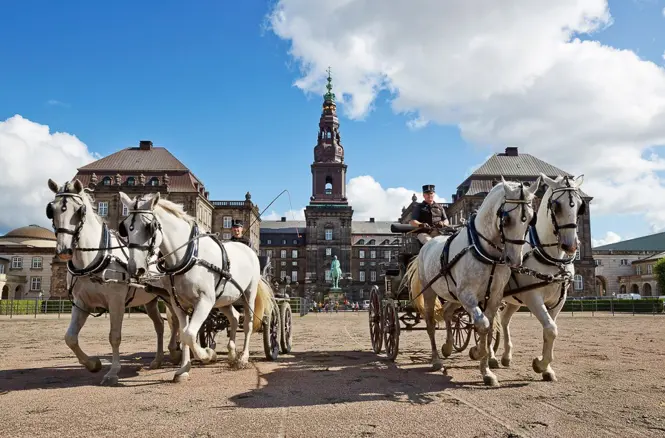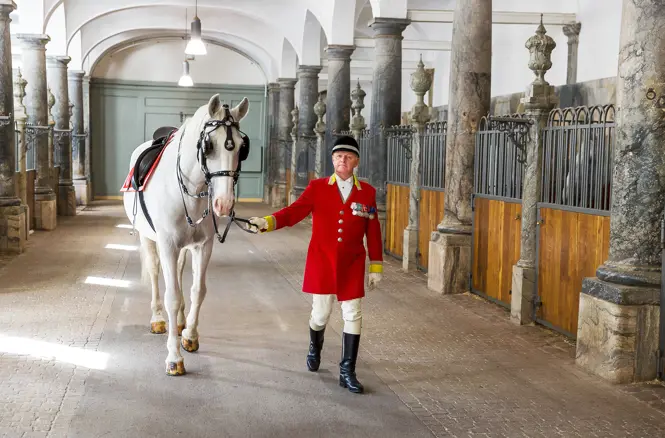
Since olden times, horse-drawn coaches have been an important means of transportation at the Royal House. Today, coaches and horses are used for official events.
Since olden times, horse-drawn coaches have been an important means of transportation. In The Royal House today, such vehicles are used only for official events, but both carriages and horses can still be seen at the Royal Stables located by Christiansborg Palace.
Behind the former royal palace, Christiansborg, you will see two curved, symmetrical wings. They date from 1746 and consequently have survived two fires that damaged the main palace in 1794 and 1884. In one wing, there have been stables for the royal horses since the middle of the 1700s, and in the other wing is an equally old, high-ceilinged, 20 x 60 meter riding arena, where one can ride horses indoors. Between the wings lies the area called ¨The Riding Ground¨.
Originally, the Royal Mews functioned as a stud farm, where horses of the noblest blood were bred for the Royal House - partly for the use of pleasure-oriented activities such as riding and hunting, partly as draft horses for the royal carriages. In 1789, the number of horses reached a total of 270 animals. Today, the Royal Mews house up to 13 horses used in connection with official events, such as state visits, the New Year’s levee, audiences with ambassadors and city visits.
In the Royal Mews, you will only find white Kladruber horses, which originated in the East Bohemian town of Kladruby nad Labem in the Czech Republic. In earlier times, white-born horses were coveted as parade horses and as draft horses for the carriages of European kings and princes. Inbreeding led to the extinction of the Royal House’s stock of white horses at the beginning of the 1900s, and a white horse had to be borrowed when Christian X crossed the border for North Schleswig’s reunification with Denmark in 1920.
At the request of Prince Henrik, it was decided in 1993 that white horses should once again be in the Royal Mews. The choice fell on the dappled horses of the Kladruber breed, which are not born white but become uniformly white over the years.
The Royal Mews are still a working building with a stable master, royal coachman, drivers and runners. The runners literally used to run alongside horse teams for extra safety and to underscore that there were important passengers inside. Today, the runners sit on the carriage.
The staff members take care of the horses, which are always ridden or driven at least one hour daily. In addition, carriages without passengers are driven through the streets of Copenhagen daily to train the horses how to move in traffic.
From 2007 to 2009, the Royal Mews underwent a thorough renovation, so today they appear modern and meet the requirements of current animal welfare laws.
Museum of the Royal Mews and Coaches
The Royal Stables are open to the public and include a museum with a collection of historic royal gala coaches and newer, lighter types of vehicles.
Opening hours
For information about the opening hours please visit the Danish Royal Palaces.
Please notice
The horses in the Royal Mews are put out to graze from the middle of June until the middle of August. It is still possible to see the carriages and collection of harness.

